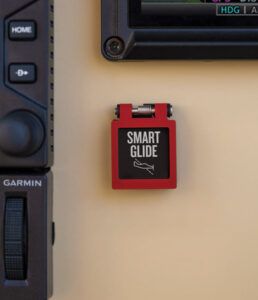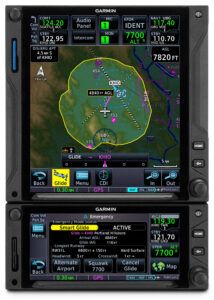 At AirVenture 2021, Garmin announced its Smart Glide feature, which is another layer in the company’s Autonomí suite of safety-enhancing tech. Some of the features in Smart Glide trickle down from Garmin’s emergency Autoland, but what’s different is that unlike Autoland, Smart Glide is available to the aftermarket through a no-charge software update (shop labor to install the update through a Garmin dealer is additional).
At AirVenture 2021, Garmin announced its Smart Glide feature, which is another layer in the company’s Autonomí suite of safety-enhancing tech. Some of the features in Smart Glide trickle down from Garmin’s emergency Autoland, but what’s different is that unlike Autoland, Smart Glide is available to the aftermarket through a no-charge software update (shop labor to install the update through a Garmin dealer is additional).
But it looks like a large chunk of the experimental aircraft market will have to wait for Smart Glide because of display compatibility, since right now it requires a TSO flight display, in addition to one (or two) of the latest GTN Xi-series navigators. To clear up some confusion that resulted from the announcement, here’s a brief Q&A.
What is Smart Glide? The feature is an add-on to Garmin GTN Xi series retrofit navigators and when activated (with a panel-mounted switch or by pressing and holding the navigator’s Direct-To key), it helps find the best suitable airfield to put down. The system also indicates the best glide speed for the aircraft’s gross weight. Similar to the fuel endurance range ring on the navigators, Smart Glide uses a yellow glide-distance range ring that automatically appears on all configured moving map pages and uses real-time data to calculate an estimated glide ratio based on current aircraft glide performance and available wind data. It offers the pilot multiple choices of airports to glide to (when there are ones within gliding range), and calculates/displays a direct navigation path to the runway environment. It changes the CDI scale of the interfaced nav indicator to 0.30 NM, tunes the comm radio to the appropriate frequency for the destination airfield and when interfaced with a compatible Garmin transponder, provides a one-touch selection for the 7700 emergency code.
 What Smart Glide isn’t: It isn’t an autonomous landing system. Unlike emergency Autoland, Smart Glide doesn’t land the aircraft. It’s up to the pilot to put the airplane on the ground (and fly it to the landing site when an autopilot isn’t interfaced).
What Smart Glide isn’t: It isn’t an autonomous landing system. Unlike emergency Autoland, Smart Glide doesn’t land the aircraft. It’s up to the pilot to put the airplane on the ground (and fly it to the landing site when an autopilot isn’t interfaced).
What are Smart Glide’s limitations? The idea behind Smart Glide is to cut directly to the chase and find the nearest suitable airfield to land. It does not provide automatic weather avoidance, vertical guidance or altitude management, although some of these features are built in to one or both of Garmin’s latest GTN Xi-series GPS navigators or from remote sensors.
What if there are no airfields within gliding distance when the engine fails? Smart Glide advises as such, while continuing to search for one. It doesn’t select an off-airport landing site, but you’ll be able to see topo data in relation to the glide-range ring.
Can Smart Glide be coupled to the autopilot? Yes, if the autopilot is Garmin’s GFC500 or GFC600. Upon activation, the autopilot servos engage (and stay engaged if Smart Glide is activated when the autopilot is on) when the aircraft is more than two nautical miles from the destination airport. Since these autopilots have airspeed hold, the system will pitch to maintain the best-glide airspeed. Smart Glide also triggers the autopilot flight director modes to target the configured best glide speed, while tracking the direct-to route to the airfield.
Are there other limitations? Smart Glide does not manage altitude. Configure the aircraft appropriately with the flaps and the landing gear (in a retrac) to make the landing yourself. Remember, this isn’t Autoland. But there are good visual cues along the way. Flashing textual annunciations alert the pilot of warning, caution and advisory conditions. These annunciations appear in a banner on the Emergency page and over the route display on the GTN Xi’s Map page. They turn solid or disappear after five seconds. There is an advisory alert (white text on a black background) that says Approaching Airport when the aircraft is 4 nautical miles out. Can’t make the field? You’ll see an Airport Out Of Range caution alert. If you make it to within 2 nautical miles, you’ll see a Maneuver And Land message warning alert.
What GPS equipment is required? Smart Glide requires a GTN 750 Xi or GTN 650 Xi navigator, which will be loaded (in the field) with software version 20.20. The software is provided to authorized Garmin dealers at no charge, but expect to pay shop labor for the software install configuration and revision to the flight manual supplement. Smart Glide won’t work with Garmin’s budget navigators—the GNX 375/GNC 355/GPS 175—or with legacy GTN units and long-discontinued GNS navigators.
Why are experimentals seemingly left out? For its initial release, Smart Glide is only compatible with Garmin’s current TSO’d retrofit flight displays, including the G500/600 TXi and the GI 275 flight instruments. It isn’t yet compatible with the G5 or the G3X Touch (experimental or certified). Garmin said it is planning more display interfaces in the future, and we suspect the G3X Touch and G5 is on the list. Garmin said the experimental G3X Touch might be a player by the end of August 2021. We’ll keep tabs on the interface on report on it as it advances.














I attended the Garmin seminar on smart glide and took away a different message. I have a “legacy” G3X non-touch and a GTN-650 in my RV-10. We were told that with the software release, expected during OSH, that it would work with my unit as long as it is on an experimental aircraft. As an aside, I will need to upgrade my TruTrak A/P to Garmin.
The presenter specifically said that it will work with the GTN-650 but the 750 will have to be upgraded to the Xi due to something with the processor. Your article indicates that it will not work on my setup.
The official word from Garmin is that while your experimental G3X Touch will eventually be a player, Smart Glide won’t work on it yet. “Perhaps around the end of August 2021,” is what we are told.
GTN navigators (750/650) must be Xi versions—not legacy. But, the experimental G3X Touch with internal GPS will be able to support Smart Glide without a GTN navigator.
This is annoying. Why would a experimental g3x smart glide work without the navigator, but the certified won’t? When the difference in equipment is just a piece of paper that says ‘Certified’?